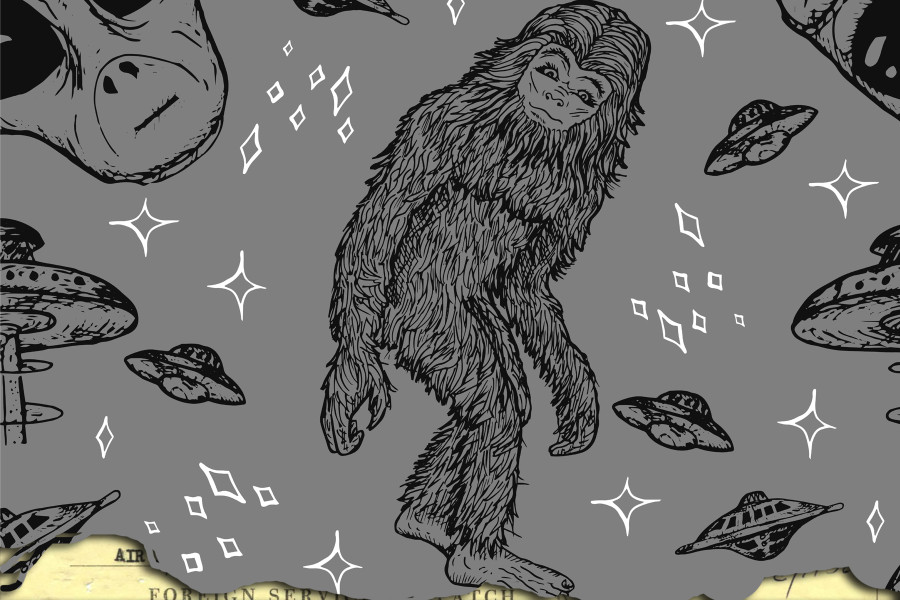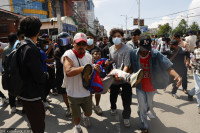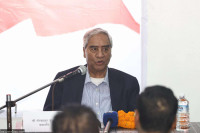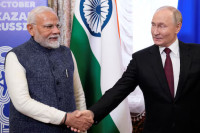Opinion
How the US kept tabs on UFO sightings and Yeti hunting in Nepal
Conspiracy theories on CIA cover-up about extraterrestrial activity aside, the note on UFOs is extremely fascinating.
Amish Raj Mulmi
On 25 March 1968, at 8.15 pm, residents of Batulechaur in Pokhara, on the way to Mahendra Gufa, witnessed an unusual phenomenon. ‘A blazing object, flashing intermittently, accompanied by big thunder sound disintegrated over Kaski region.’ Although urbanised today, Batulechaur would have been little more than a few homes amid rice fields at the time. Pokhara itself was a sleepy town, centred around the north-south axis of Bagar to Ramkrishna Tole, the old market. The American Central Intelligence Agency (CIA), however, found the phenomenon interesting enough to classify it as an unidentified flying object (UFO) in a report dated 13 June 1974. Most intriguingly, the document noted that ‘a huge metallic disc-shaped object with a six-foot base and four feet in height was found in a crater at Baltichaur (sic), five miles NE of Pokhara.’
Is the truth out there?
This was not the only instance of UFO spotting by the CIA in our part of the world. Although the sources have been redacted, presumably for security reasons, similar bright objects were seen in the skies above Ladakh, Thimphu, Sikkim, and Olangchung Gola and Ghunsa in the east of Nepal, where ‘a fast-moving object, long and thin, emitting red and green bright light, as bright as to cause daylight’ was seen on the night of 19 February 1968. The document covers UFO sightings between February–March 1968, during which there were seven such sightings in these areas.
The report is part of a trove of documents the CIA declassified and released in 2017. As expected, the archives focused on Nepal cover Cold War geopolitics, American preoccupation with Communist presence in Nepal, Sino-Soviet aid, and Indian outlook towards the country. There are also notes about the early days of democratic Nepal. A 3 January 1950 note reads, ‘Many of the ruling Ranas [...] are purchasing property outside of Nepal...They fear the Communist menace which is mostly indigenous....Congress party members seem to be operating in concert with the Communist party against the government’. In 1953, after the flight of K.I. Singh to China, a CIA note read: ‘In early November 1953, K.I. Singh was staying in a village near Tradum [Tibet]...where the Chinese Communists had established for him a headquarters where he could organise and train Nepalese Communists.’ A footnote adds, ‘[redacted] in April 1952 Dr. Kaiser Indra Singh [sic]’s followers in Tibet were being trained by Chinese Communist Army officers’. Notably, none of the archives related to Project ST Circus, the CIA covert operation that trained and inserted Tibetan Chushi Gangdruk guerrilla fighters into Tibet via Mustang and other upper-Himalayan regions, has been released.

The note on the UFOs is short. There aren’t any explanations provided, or if there are, they’ve been redacted. Extraterrestrial explanations aside, could the sightings simply be countries testing out new surveillance aircraft? The CIA suggested the agency was itself responsible for ‘reports of unusual activity in the skies in the 50s’; turns out they had been testing the U-2 high-altitude reconnaissance aircraft secretly. In a report that declassified the development of the U-2 programme, it said the aircraft could fly up to 73,600 feet, and ‘access to the photographs...would be strictly controlled.’ One assumes inter-departmental secrecy meant those who drew up the UFO sightings note did not know about the U-2 flights until much later. From the report’s conclusions, it is clear that testing of the new aircraft resulted in several sightings from across the world. ‘High-altitude testing of the U-2 soon led to an unexpected side effect – a tremendous increase in reports of unidentified flying objects...once U-2s started flying at altitudes above 60,000 feet, air-traffic controllers began receiving increasing numbers of UFO reports,’ the highly redacted report reads, ‘U-2 and later OXCART (another high-altitude spy plane) flights accounted for more than one-half of all UFO reports during the late 50s and most of the 1960s.’
We cannot say what the ‘huge metallic disc-shaped object’ that crashed in Batulechaur was, since we don’t know what happened to the remains. If it were a part of the aircraft, one would assume US authorities would have gathered it. There aren’t any other declassified reports about UFO sightings from our part of the world, although other reports count sightings from Sweden, Denmark, West Germany and Turkey.
Conspiracy theories on CIA cover-up about extraterrestrial activity aside, the note on UFOs is extremely fascinating. It tells us about the agency’s breadth of coverage in a country, especially because Nepal at the time was largely remote, with little or no transport infrastructure to speak of. How did the information from Olangchung-Ghunsa—which remains difficult to reach even in the modern day—reach US authorities?
However, this was not the only instance of the X Files playing out in Nepal. On 30 November 1959, the American embassy in Kathmandu sent out a memo to the State Department about the Himalayas’ best-kept secret: the Yeti. The memo curiously outlines three regulations ‘applicable only to expeditions searching for the Yeti in Nepal’. A background blog suggests the regulations had been issued by the Nepal government ‘two years before’ and then translated to English, and it makes for an irresistible read.
Yeti ‘hunters’
The first of the regulations stipulated any expedition to look for the Yeti would have to pay a royalty of INR 5000 to the government. If the Yeti was found, ‘it can be photographed or caught alive but it must not be killed or shot at except in self-defense.’ Any photographic evidence, or if the Yeti was caught alive or dead, was to be submitted to the Nepal government. Also, any news or reports about the Yeti could not be released to the press without permission from the government.
But where the note gets interesting is the background blog that suggests even though the US government did not believe in the existence of the Yeti, ‘the memo was instead a strategic move to demonstrate the US support of Nepal sovereignty.’ Nepal’s position as a strategic buffer between India and China, two countries the US wasn’t particularly close to at the time, meant the US needed a presence in the country so that it could monitor the two, as well as Soviet influence in the country. However, ‘both India and Nepal were wary of Western imperialist nations, but the US needed Nepal’s approval to maintain an embassy within Nepal’s border and—on a larger scale—they needed India’s political support in the region.’ The memo was a signal that the US diplomatic presence in Nepal was ‘entirely non-threatening’.
The backgrounder’s explanation is quite unsatisfactory. After all, US presence in Nepal also served to soothe the nerves of a Nepali establishment already wary of overreaching Indian and Chinese influence at the time. The two neighbours had, in any case, entered into treaty agreements by the date of the memo recognising Nepal’s sovereignty. A memo on Yeti hunting would not satisfy the two neighbours about the US’s ‘non-threatening’ presence.
However, if we consider the idea that the memo had been issued at a time when western ‘explorers’ were scouring the mountains for signs of the Yeti, it makes more sense. The most (in)famous of these explorers was Peter Byrne, who headed a 1957 expedition funded by Texas oil millionaire Tom Slick. On Slick’s instructions, Byrne nicked a finger from the famous Pangboche monastery hand, which purportedly belonged to a Yeti, in 1958. Although Byrne, who was most recently sentenced for fraud in the US, later said the monks allowed him to take a finger after he made a donation of Rs.10,000 to the monastery, an Everest summiteer who started a campaign to ‘return the hand’ to the monastery suggests Byrne got a monk drunk and stole the finger. ‘While the monk was passed out with a tummy full of scotch, Peter cut a finger off from the original Yeti hand and replaced it with a human bone. The monks were none the wiser.’
Whatever the truth, what was clear was that the finger was illegally smuggled to the UK, another relic that joined the list of artifacts smuggled from Nepal to the private collections and museums of the west. The Pangboche hand has now been proven to be hominid in origin, and perhaps the mystery of the Yeti itself has already been debunked to more unremarkable explanations, just like the UFOs.
Mulmi tweets at @amish973




 12.12°C Kathmandu
12.12°C Kathmandu








%20(1).jpg&w=300&height=200)

